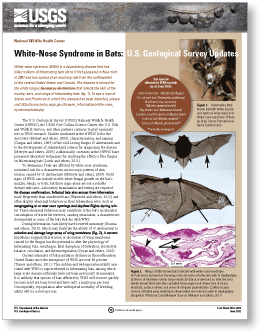
Summary
White-nose syndrome (WNS) is a devastating disease that has killed millions of hibernating bats since it first appeared in New York in 2007 and has spread at an alarming rate from the northeastern to the central United States and Canada. The disease is named for the white fungus Geomyces destructans that infects the skin of the muzzle, ears, and wings of hibernating bats.
The U.S. Geological Survey (USGS) National Wildlife Health Center (NWHC), the USGS Fort Collins Science Center, the U.S. Fish and Wildlife Service, and other partners continue to play a primary role in WNS research. Studies conducted at the NWHC led to the discovery (Blehert and others, 2009), characterization, and naming (Gargas and others, 2009) of the cold-loving fungus G. destructans and to the development of standardized criteria for diagnosing the disease (Meteyer and others, 2009). Additionally, scientists at the NWHC have pioneered laboratory techniques for studying the effects of the fungus on hibernating bats (Lorch and others, 2011).
To determine if bats are affected by white-nose syndrome, scientists look for a characteristic microscopic pattern of skin erosion caused by G. destructans (Meteyer and others, 2009). Field signs of WNS can include visible white fungal growth on the bat’s muzzle, wings, or both, but these signs alone are not a reliable disease indicator—laboratory examination and testing are required for disease confirmation. Infected bats also arouse from hibernation more frequently than uninfected bats (Warnecke and others, 2012) and often display abnormal behaviors in their hibernation sites, such as congregating at or near cave openings and daytime flights during winter. These abnormal behaviors may contribute to the bat’s accelerated consumption of stored fat reserves, causing emaciation, a characteristic documented in some of the bats that die with WNS.
During hibernation, bats likely have lowered immunity (Bouma and others, 2010), which may facilitate the ability of G. destructans to colonize and damage large areas of wing membrane (fig. 2). A current hypothesis suggests that erosion or ulceration of wing membrane caused by the fungus has the potential to alter the physiology of hibernating bats, resulting in fatal disruption of hydration, electrolyte balance, circulation, and thermoregulation (Cryan and others, 2010).
Current estimates of bat population declines in the northeastern United States since the emergence of WNS are over 80 percent (Turner and others, 2011). This sudden and widespread mortality associated with WNS is unprecedented in hibernating bats, among which large-scale disease outbreaks have not been previously documented. It is unlikely that species of bats affected by WNS will recover quickly because most are long-lived and have only a single pup per year. Consequently, repopulation after widespread mortality of breeding adults will be a slow process.
Worldwide, bats play essential roles as pollinators, seed dispersers, and as primary consumers of insects. The true ecological consequences of the recent large-scale reductions in populations of hibernating bats are not yet known. However, farmers might feel the impact. A recent economic analysis indicated that insect control services (ecosystem services) provided by bats to U.S. agriculture is valued between 4 to 50 billion dollars nationwide per year (Boyles and others, 2011). The number of North American bats estimated to have died from WNS thus far had the capacity to consume up to 8,000 tons of insects per year (Boyles and others, 2011).
The area of North America affected by WNS continues to expand. Within the last 2 years, the disease has been confirmed in several Central States, including Alabama, Indiana, Kentucky, Ohio, Tennessee, and Missouri. High mortality of bats has not yet been reported at these locations, and it remains to be seen if WNS will develop and manifest in other States with the same severity as that in the Northeast.
|
First posted July 3, 2012
Part or all of this report is presented in Portable Document Format (PDF); the latest version of Adobe Reader or similar software is required to view it. Download the latest version of Adobe Reader, free of charge. |
